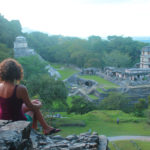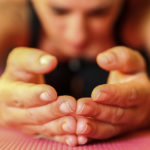It can be difficult to practice compassion toward ourselves when faced with an injury.
We get frustrated with our bodies. We become self-critical when we don’t heal fast enough.
But to heal, we need kindness and compassion.
Today I want to share with you 3 key components of practicing compassion.
But first, a story.
I recently went backpacking and camping for a week in the southwest.
On day two, we were canyoneering through the Narrows in Zion National Park when I began to feel intense shooting pains in the joint capsule of my knee.
We were in the middle of a canyon applying agility with every precipitous stepping stone–and a good 10-hour hike away from being out of the canyon the next day.
Thoughts whirled in my mind.
How was I going to hike all this way?
Why is my body behaving like this for? I am a yoga practitioner and avid hiker. I don’t have knee problems.
Ow, it really hurts.
What if continuing this hike jacks up my knee permanently? I’m turning 34. How will I hike in my 60s?
I don’t want to complain. How would my stepdad have reacted? He never complained of the suffering he endured with Mesothelioma. Let me be like him. And what about my mom–her response to suffering? Oh god, this is just a knee…
Ouch.
Trauma sprung. Tears came pouring. There’s a lot I could say here, but…
I made it out of the Narrows. My knee returned to its strength and I returned to my mat.
When I got back to Chicago, a clumsy collision with a door frame at home landed me with a broken phalange. Bam. Crack. Uff.
I hobbled for 8 days with a poor tape job on my baby toe before seeing a podiatrist (apparently, taping the fifth toe to the fourth is a no-no).
I also hobbled along with a poor excuse to not do my yoga practice, but continued to walk, move things, teach yoga, and even audition at a studio–all while in a great deal of pain.
One of my yoga teachers advised me to do standing poses. Inside I balked, but realized maybe he was right. It is just my baby toe after all. Maybe continuing through the pain would help the healing process. Stop creating excuses, mind.
Then I asked the podiatrist if I could do yoga, he replied with an emphatic, “Nooooooo. Stay off it. It needs to rest.” And the mind said…”Yep, best to stay off of it. Excuse okay here.”
As competing thoughts patterns inhabited my mind, I acknowledged that what lies between is a middle path…a middle path that honors ahimsa, the Sanskrit word for “compassion” or “nonviolence”.
Ahimsa is rooted in the notion that violence can take place in our thoughts, words, and actions and when we have ill thoughts, they lead to derisive words and harmful actions. These, in turn, create destructive habits and ignorant conditioning. When we do harm to ourselves, we harm others and vice versa.
I constantly remind myself that yoga is not just asana (physical poses). The yoga practice takes place off the mat in how we lives our lives, interact with others, treat ourselves, etc. But to only practice off the mat can impede our ability to practice tapas (self-discipline). And providing space for tapas serves as our point of reference to continuously do the work of yoga.
I would be a fraud if I suggested I am over this battle in my head. It is never over. It’s always there.
It is a constant practice of listening to the body and choosing compassion. Nonviolence is not passive; it is active, intentional thought, word, or action or absence thereof. It is a balance of allowing rest and still forcing myself to move past excuse and onto my mat in a way I know is good for me right now. I have adapted my Mysore practice accordingly. See below for more info.
3 Ways to Practice Compassion During Injury:
1. Track your thoughts:
In yoga, we practice observing our thoughts when faced with discomfort and challenging emotions. Still, we tend to disavow both our strengths and weaknesses, breakthroughs and shortcomings. This is a balance of examining where you can push and where you can pull back, where you need perseverance and where you need gentleness. Where are you being too harsh? Where are you making excuses? They both warrant a turn to ahimsa.
I have been taking 10 minutes each morning to meditate and 30 minutes to journal. It is a practice of stillness while simply observing thoughts and then allowing time to reflect on paper. Even if you can only devote 10 minutes to sit in stillness and observe what comes up, this will have a profound impact on your life.
2. Watch your words.
Words often follow thoughts. And they have power. I have found myself uttering the words “my stupid broken toe” or “my friggin’ knee”. Each time, I have immediately recanted my words as I realized these words were unkind and not useful for my body. I love my toe. I love my knee. I love my body.
Words also make actions more real. I recently told my boyfriend, that I was making a commitment to self-care and compassion for myself–a commitment to myself and the women I will be holding retreat space for in January. I wake up at the same time every morning to meditate for 10 minutes, journal for 30, and then practice yoga for an hour in a way that honors where my body is that day–the same practice I will be asking of the women. Stating that commitment aloud has made it easier to stay on track with my own self-compassion.
If you are working through a particular issue and find the same negative thoughts, words and speech arising, take a moment to journal the new thoughts and words you would like to generate in place of the negative ones. Use those affirmations in your thoughts and verbal processes.
3. Attend to your actions.
You only get one body. If you are experiencing an injury or pain of any sort, let this be a time to make friends with your body. We are hypercritical of our thighs, skin, achy joints, and lack of flexibility. Make a conscious choice to fall in love with yourself–every aspect of you.
The only way you will hear how to best nourish your body is if you take time to really hear it. I went to a talk last night by a wonderful teacher and storyteller, James Boag. He reminded us that wild animals are always fit. They know exactly how to eat, when to eat, and how to move as part of their inherent instincts. I would go further and suggest they also know what their abilities and limitations are in times of injury. And they bounce back. They recover quickly.
Through these last two minor injuries (and they are minor!) I have experienced some fear and uncertainty. But it is only fear. When I really listen, my body tells me what it needs. It is unnecessary to follow all of the other voices around me. And it always needs movement and yoga–in a way that respects the principle of ahimsa.
How I adapt my Mysore practice:
You may have seen this video circulating on Facebook at some point. It shows a great way to modify the entire Ashtanga Primary Series without standing poses.
If this guy with a broken femur could continue his practice–anyone can practice. My little toe certainly is not going to stop me. The practice certainly feels different, but I find it still creates heat and offers most of the same benefits.
Have you had an injury that has affected your practice? How do you practice compassion?






